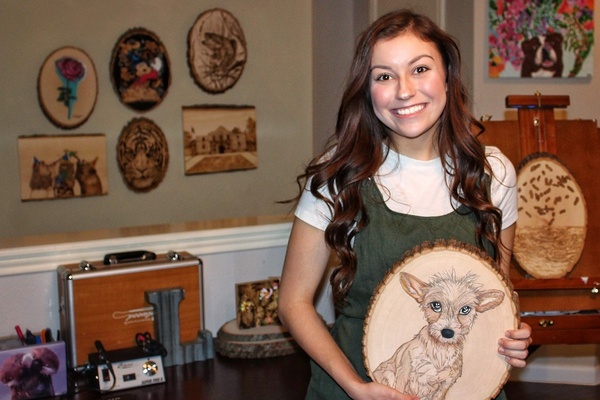Wood Burning Art For Beginners: 7 Ideas According to an Expert
Updated by Sarah Baird
If you’re looking for a hobby that’s been around as long as humankind but still flies largely under-the-radar for beginning crafters, look no further than wood burning art . Also known as pyrography—which literally means “fire writing” in Greek—this craft might sound straight out of Rebel Without a Cause , but woodburning artists swear by its relaxing, meditative properties. (Yes, fire and all.)
“Wood burning, also known as pyrography, is an art form where you hand decorate wood with the burn marks of an applicator,” explains Loren Day, a 26-year-old wood burning artist from San Antonio, Texas . “Using wood burning pens, you can create intricate or simple designs, whether it be by free-handing an illustration or pre-drawing onto a piece of wood.”
Ready to grab your** ultra-hot drawing utensil and get to work **? Loren outlines a few tips and tricks for beginners below.

1. Take a Test Run
Before searing into your tree-ring canvas, always test your wood burning pen on a scrap piece of wood to ensure you’re familiar with the tool and how it functions. Test runs also help reinforce pen safety and form. (For example, if your pen is smoking while you work, it’s too hot and needs to be cooled down.)
2. Use a Light Wood
Light-colored soft woods that will readily accept design with an attractive external bark (looking at you, willow wood ) are go-to favorites among pyrographers. “I recommend using basswood . That's my favorite one with the natural bark on the edges. I think that's the most common wood for wood burning art,” says Loren. “There's also birch and pinewood. You’ll typically see a lot of light-colored woods with little grain, because a blank canvas is preferred—especially for intricate work. Pieces that do contain more knots or grain can create a challenge. You can try to implement them into your work, so that's really good if you’re trying to be very creative.”
3. Know Your Tools
Much like paint brushes come in a seemingly infinite number of styles and sizes, there’s a wide range of wood burning tools with various tips (like cone-shaped and chisel), temperature controls, and accessories ideal for getting down in the nitty-gritty of elaborate pyrography designs.
Loren started off with the Walnut Hollow Creative Woodburner Value Pen , which she recommends for beginners, the only drawback being that it “doesn't have a temperature setting, so it does get very hot in your hand.” She eventually upgraded to the light-weight** Creative Versa-Tool ** (with temperature setting, of course) which allowed her to wood burn “for hours on end” and also provided a variety of different tip shapes and sizes, helping to improve the detail elements of her work.
When her career as a wood-burning artist really took off, she received the Colwood Super Pro . “It’s a more expensive wood burner, so you can definitely tell the difference in quality. It has lots of different settings and tips to apply to the wood as well.”
4. Have a Gentle Touch
Pulling, swinging, scumbling, sweeping—there are all sorts of drawing and shading techniques utilized by wood burners to get just-the-right look in their art. When you’re starting out, though, resisting the urge to press down hard into the wood can be a challenge. Instead, use a gentle touch, go slowly, and let the tool work for you: no excess force required.

5. Pattern Work
Loren often uses her freehand illustration skills to create pet portraits for clients, but she suggests wood burners who are honing their craft start by using pre-drawn patterns and stencils. “There are lots of stencil patterns you can find if you go online, and there are books as well. You can pretty much make anything into a stencil by printing out a picture on a piece of paper then using a pencil to color the back of the paper. Whenever you lay it over the piece of wood and trace the outline of the design, it'll come out on the wood.”
6. Start ‘Em Young (If You Want)
If you’re searching for a parent-child or aunt-nibling activity to dive into with your favorite tween, wood-burning art has just enough “wow!” factor to impress even the most skeptical middle schooler. “I first started wood burning when I was in eighth grade as an assignment in my advanced art class, and from there it just kind of grew over time,” Loren laughs. “I definitely recommend it for anyone that age—particularly detailed-oriented people.” Always use caution when handling such a (very, very) hot object, use the tool’s kickstand to keep it off any table surfaces, and never allow kids or pets around a wood burning project unsupervised: this art-tool can get up to 750°F!
7. Zen Out
There’s a meditative quality to pyrography, and no matter where you are in your wood burning journey, the concentration and flow-state required to create a new piece helps bring everything into a more relaxed focus at the end of a long day. “I definitely use wood-burning whenever I need to step away and take a breather. It calms me down a little bit just working on the craft, whether it’s very simple or something really intricate. It's all up to you, and you’re in control, which is nice.”
If you’re a creative, hands-on person itching to learn a new skill, look no further than our skill-building craftsman crate !














